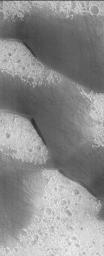Big sand dunes! Mars is home to some very large, windblown dunes. The dunes shown here rise to almost 100 meters (275 feet) at their crests. Unlike dunes on Earth, the larger dunes of Mars are composed of dark, rather than light grains. This is probably related to the composition of the sand, since different materials will have different brightnesses. For example, beaches on the island of Oahu in Hawaii are light colored because they consist of ground-up particles of seashells, while beaches in the southern shores of the island of Hawaii (the "Big Island" in the Hawaiian island chain) are dark because they consist of sand derived from dark lava rock.
The dunes in this picture taken by the Mars Orbiter Camera (MOC) are located on the floor of an old, 72 km-(45 mi)-diameter crater located northeast of Syrtis Major. The sand is being blown from the upper right toward the lower left. The surface that the dunes have been travelling across is pitted and cratered. The substrate is also hard and bright--i.e., it is composed of a material of different composition than the sand in the dunes. The dark streaks on the dune surfaces area puzzle...at first glance one might conclude they are the result of holiday visitors with off-road vehicles. However, the streaks more likely result from passing dust devils or wind gusts that disturb the sand surface just enough to leave a streak. The image shown here covers an area approximately 2.6 km (1.6 mi) wide, and is illuminated from the lower right.
Malin Space Science Systems and the California Institute of Technology built the MOC using spare hardware from the Mars Observer mission. MSSS operates the camera from its facilities in San Diego, CA. The Jet Propulsion Laboratory's Mars Surveyor Operations Project operates the Mars Global Surveyor spacecraft with its industrial partner, Lockheed Martin Astronautics, from facilities in Pasadena, CA and Denver, CO.

 Planetary Data System
Planetary Data System












